Understanding consumer intent is the cornerstone of creating successful Google Ads campaigns.
By tapping into what potential customers are actively seeking, businesses can craft messages that resonate deeply and drive meaningful engagement.
But how do you harness this intent effectively?
In this article, we’ll dive into actionable strategies that help you align your ads with consumer intent, ensuring your campaigns perform at their best.
- Understanding Consumer Intent in Google Ads
- Crafting Ads that Capture Consideration Phase Intent
- Optimizing Google Ads for Better Consumer Intent Targeting
- Leveraging Google Ads Features to Harness Consumer Intent
- Common Mistakes in Targeting Consumer Intent with Google Ads
- Mastering Consumer Intent for Successful Google Ads Campaigns
- Frequently Asked Questions About Consumer Intent in Google Ads
Understanding Consumer Intent in Google Ads
Consumer intent is the motive or objective behind a user’s search or interaction online.
It uncovers what the user is looking for, whether researching a product, comparing options, or making a purchase.
In Google Ads, this understanding of intent enables advertisers to craft highly targeted campaigns that meet potential customers at the right stage of their journey.
Why is this so important?
Simply put, aligning your ads with consumer intent can dramatically increase your campaign’s effectiveness.
When users see ads that directly address their needs or questions, they’re more likely to engage, click, and convert.
It’s about being there at the moment that matters most to them.

Symbolic visualization of consumer intent in the digital marketing context.
What is Consumer Intent?
Consumer intent can be broadly categorized into three types:
- Informational Intent: When people look for information to understand answers or concepts.
- Navigational Intent: When users look directly for a website or a particular brand.
- Transactional Intent: When a person wants or is about to undertake an activity like a purchase of a service or product.
Each type of intent plays a critical role in shaping how you structure your campaigns.
By understanding where your audience falls within these categories, you can tailor your messaging to meet their needs.

Illustration highlighting the critical role of consumer intent in optimizing Google Ads campaigns.
Why Consumer Intent Matters for Google Ads
Imagine you run ads for a fitness program.
A user searching for “best fitness plans for beginners” is in the informational phase, whereas a user searching for “buy fitness plan subscription” is closer to the transactional phase.
Knowing this distinction allows you to craft ad copy and choose keywords that speak directly to their current mindset.
By aligning your ads with consumer intent, you:
- Increase click-through rates by delivering relevant messages.
- Lift conversions by targeting users ready to take action.
- Maximize your ad spend on high-intent audiences.
In Google Ads, relevance is king, and understanding consumer intent is the key to getting there.
Understanding consumer intent enables advertisers to tailor campaigns effectively, aligning with user needs and maximizing engagement.
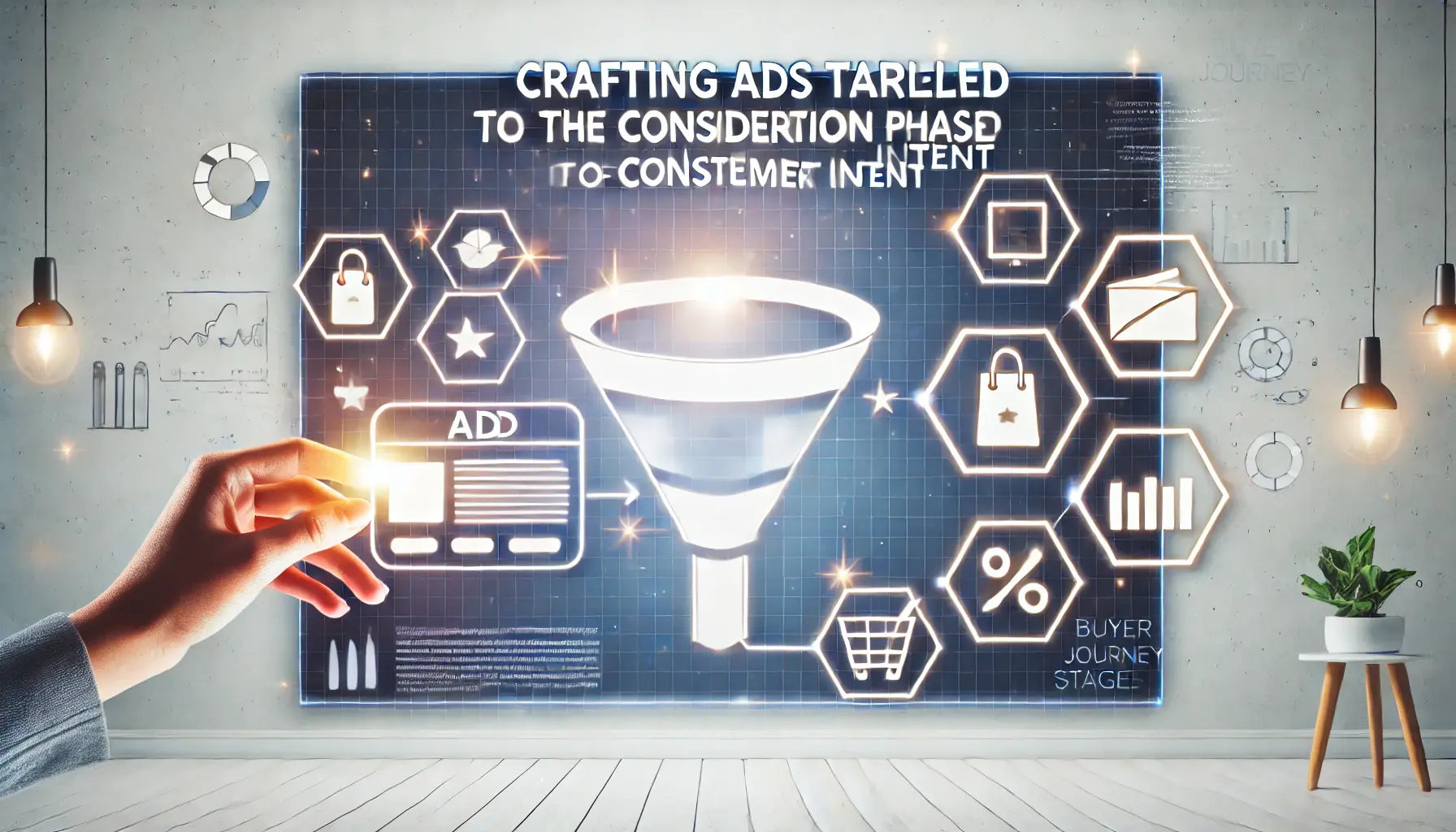
Illustration of strategies for creating ads tailored to the consideration phase of consumer intent.
Crafting Ads that Capture Consideration Phase Intent
Targeting the consideration phase of consumer intent in Google Ads requires precision and an understanding of how users evaluate their options.
In this phase, users are aware of their needs and are actively exploring solutions but have not yet made a decision.
Your goal is to position your offering as the best choice by highlighting its unique value and relevance to their intent.

Visualization of the process of identifying consumers in the consideration phase of their buyer journey.
Identifying Consumers in the Consideration Phase
Recognizing consumers in the consideration phase involves analyzing their search queries, behavior, and preferences.
These users often use comparison-based keywords, such as “best,” “vs,” or “reviews.” For example:
- “Best running shoes for beginners”
- “Product X vs Product Y”
- “Reviews for top-rated fitness trackers”
By understanding these queries, you can tailor your ads to address their needs and provide the specific information they are seeking.

Illustration emphasizing the creativity and precision in crafting value-focused ad copy.
Creating Value-Focused Ad Copy
Ad copy plays a critical role in convincing users during the consideration phase.
To capture their interest:
- Highlight unique selling points: Emphasize what sets your product or service apart from competitors.
- Use persuasive language: Incorporate action-oriented words that encourage users to click, such as “explore,” “discover,” or “learn more.”
- Address pain points: Show how your offering solves specific problems or meets unique needs.
For example, if you’re promoting a meal delivery service, your ad might read: “Save time and eat healthy – Explore our fresh, chef-crafted meal plans today!”

Visualization of the power of audience segmentation in Google Ads campaigns.
Leveraging Audience Segmentation in Google Ads
Audience segmentation enables targeting specific groups of users according to their behaviors, demographics, and interests.
By applying Google Ads tools like custom audiences and in-market segmentsAudience groups in Google Ads consisting of users actively considering purchasing products or services., you can ensure your ads appear in front of those who are more likely to convert.
Examples of effective segments include:
- Users who have recently searched for similar products or services.
- Users who visited your website but didn’t purchase anything.
- Users within a specific age or interest group that aligns with your target audience.

Illustration of effective ad formats used to emphasize key information in advertising campaigns.
Using Ad Formats to Highlight Key Information
Choosing the right ad format can significantly impact how well your ads perform during the consideration phase.
Options like responsive search adsAn ad format in Google Ads that automatically adjusts content to show the most relevant message. and display ads allow you to visually showcase your product and emphasize its benefits.
Consider including:
- High-quality images or videos that showcase your product in action.
- Clear call-to-action buttons, such as “Compare Now” or “Learn More.”
- Interactive features, like carousels, to display multiple product options.
By crafting ads that speak directly to the intent of users in the consideration phase, you can build trust, demonstrate value, and guide them toward choosing your product or service.
Focus on unique value propositions and audience-specific messaging to capture attention during the consideration phase.

Visualization of strategies for optimizing Google Ads to better target consumer intent.
Optimizing Google Ads for Better Consumer Intent Targeting
Effectively targeting consumer intent in your Google Ads campaigns requires a strategic approach that aligns with user behaviors and search patterns.
By optimizing your campaigns to meet these intents, you can enhance engagement and drive higher conversion rates.

Illustration of the process of conducting keyword research with a focus on consumer intent.
Keyword Research with Consumer Intent in Mind
Keyword research needs to be intensive to find and grasp consumer intent.
Identify keywords associated with various stages of a buyer’s journey, such as:
- Informational Keywords: Phrases incorporating “how to,” “best ways to,” and “benefits of” describe informational searches.
- Commercial Investigation Keywords: Key phrases include “top,” “best,” or “reviews.”
- Transactional Keywords: Keywords including “buy,” “discount,” or “order” show readiness to make a purchase.
By categorizing and targeting these keywords appropriately, you can tailor your ads to match the specific intent of your audience.
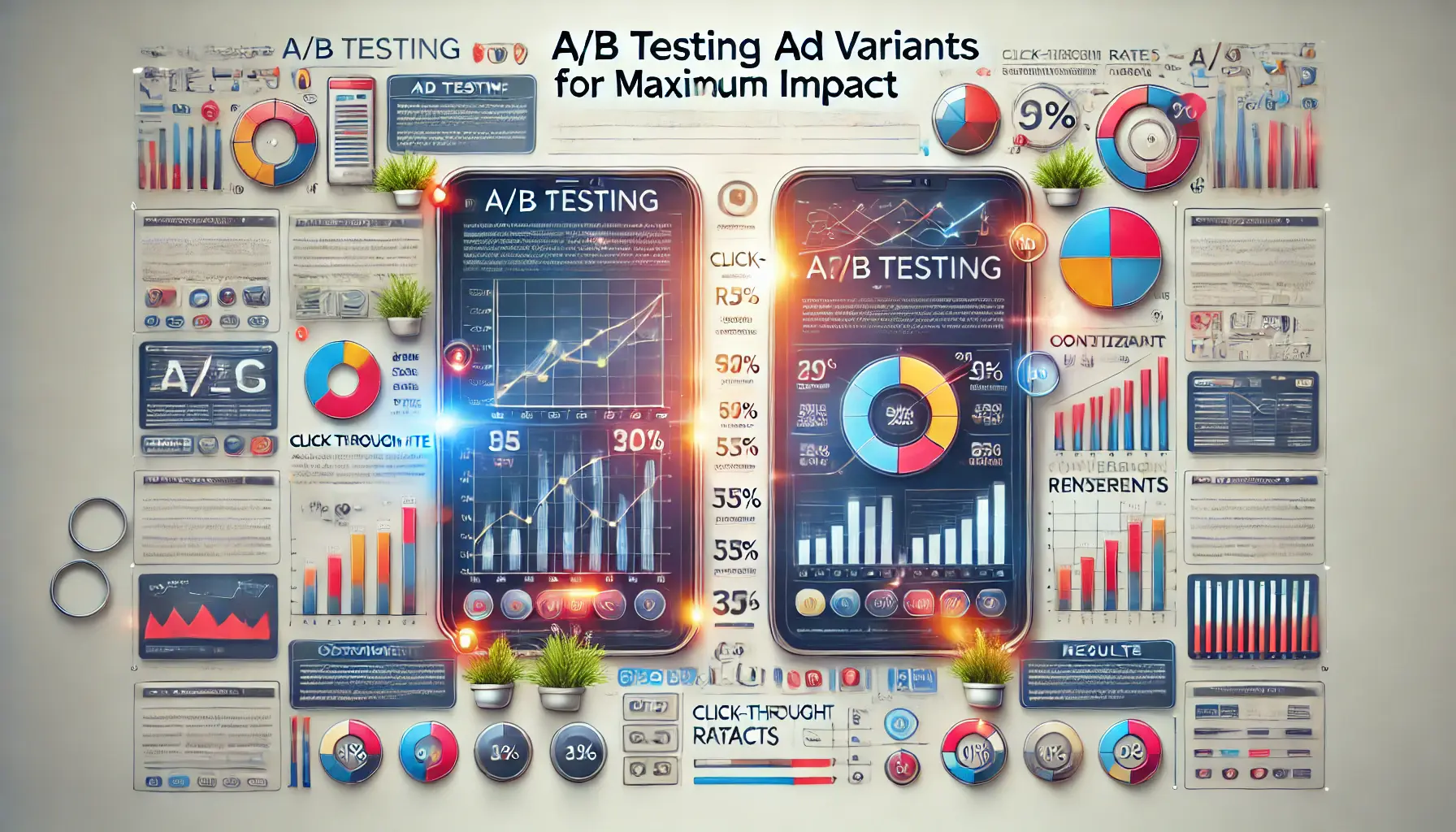
Illustration of A/B testing ad variants to determine the most effective design and messaging.
A/B Testing Ad Variants for Maximum Impact
Implementing A/B testing allows you to determine which ad elements resonate most with your target audience.
Test different versions of your ads by varying:
- Headlines and descriptions to see which messages drive higher engagement.
- Call-to-action phrases to identify what prompts users to act.
- Visual elements, such as images or videos, to assess their impact on click-through rates.
Analyzing the performance of these variants enables you to refine your ads for optimal effectiveness.

Visualization of refining campaign goals to match user behavior through data-driven decision-making.
Refining Campaign Goals to Align with User Behavior
Aligning your campaign objectives with user behavior ensures that your ads meet consumers at the right stage of their journey.
Consider the following strategies:
- Set Specific Goals: Define clear objectives, such as brand awareness, lead generation, or direct sales, to guide your campaign strategy.
- Utilize Audience Segmentation: Segment your audience based on demographics, interests, and behaviors to deliver more personalized ads.
- Leverage Optimized Targeting: Use Google’s optimized targeting to reach users most likely to convert based on real-time data and performance metrics.
By refining your campaign goals and targeting methods, you can create more relevant and effective ads.
Illustration of the process of tracking and analyzing intent metrics for digital marketing.
Tracking and Analyzing Intent Metrics
Monitoring key performance indicators (KPIs) related to consumer intent provides insights into your campaign’s success.
Focus on metrics such as:
- Click-Through Rate (CTR): Measures the effectiveness of your ad copy and relevance to user intent.
- Conversion Rate: Indicates how well your ads and landing pages convert clicks into desired actions.
- Bounce Rate: Helps determine whether users find your landing page content relevant to their search intent.
Regular analysis of these metrics helps you make data-driven adjustments to improve campaign performance.
By applying these optimization practices, you can enhance your Google Ads campaigns to better capture consumer intent, improve engagement, and achieve higher conversion rates.
Refining campaigns with A/B testing and targeting high-intent keywords ensures alignment with user behavior.
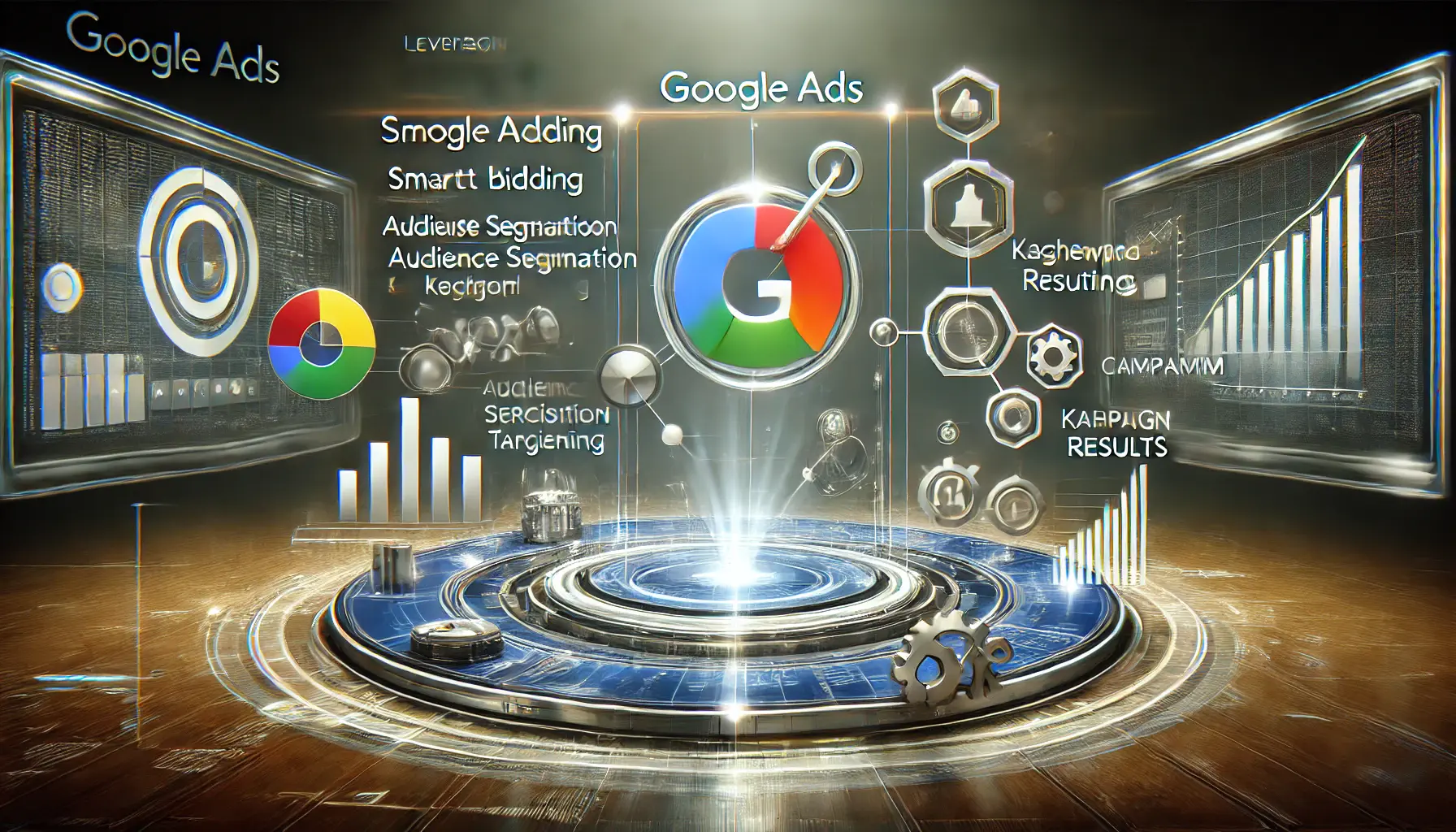
Visualization of Google Ads features used to harness consumer intent and improve campaign performance.
Leveraging Google Ads Features to Harness Consumer Intent
Effectively capturing consumer intent in your Google Ads campaigns involves utilizing advanced features designed to align your ads with user behaviors and search patterns.
By leveraging these tools, you can enhance targeting precision and improve campaign performance.

Illustration of how audience segments can be used for precise targeting in Google Ads.
Utilizing Audience Segments for Precise Targeting
Google Ads offers various audience segment options to help you reach users based on their interests, behaviors, and demographics:
- Affinity Segments: Reach users based on their passions and habits.
- Custom Segments: Create audiences by entering relevant keywords, URLs, and apps to target users actively searching for specific topics.
- In-Market Segments: Target users who are actively considering purchasing products or services similar to yours.
By applying these audience segments, you can ensure your ads are shown to users whose intent aligns with your offerings.
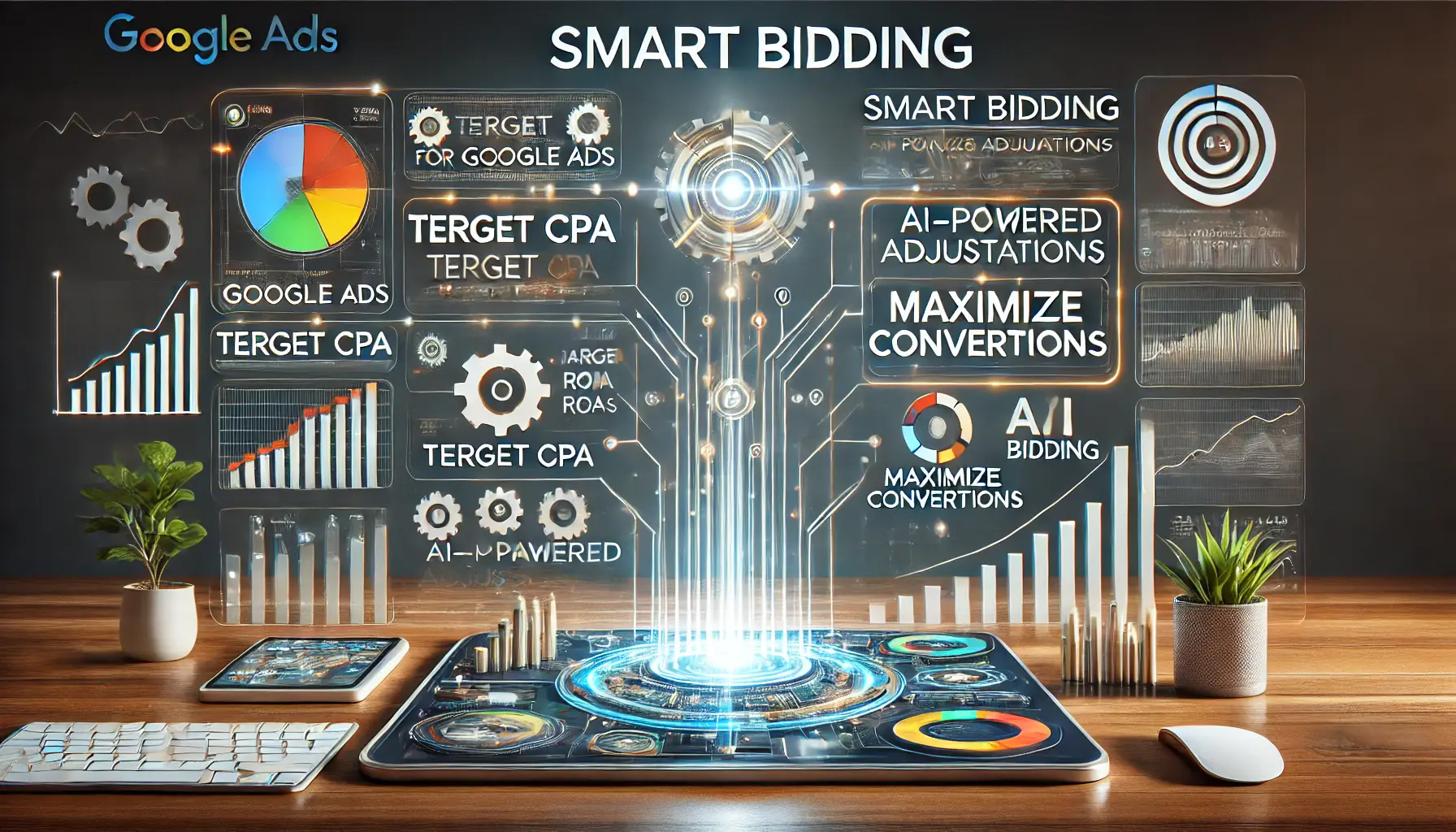
Visualization of implementing Smart Bidding strategies in Google Ads for optimized campaign performance.
Implementing Smart Bidding Strategies
Smart Bidding utilizes Google AI to optimize bids for conversions or conversion value in each auction.
Key Smart BiddingAn automated bidding strategy in Google Ads that uses machine learning to optimize conversions or conversion value. strategies include:
- Target CPA (Cost Per Acquisition): Sets bids to help get as many conversions as possible at the target CPA you set.
- Target ROAS (Return on Ad Spend): Bids to maximize conversion value while achieving the target ROAS you set.
- Maximize Conversions: Automatically sets bids to help get the most conversions within your budget.
- Maximize Conversion Value: Sets bids to achieve the highest total conversion value within your budget.
These strategies allow for real-time bid adjustments based on various signals, enhancing your ability to meet specific campaign goals.

Visualization of employing custom segments to enhance relevance and targeting in Google Ads.
Employing Custom Segments for Enhanced Relevance
Custom segments enable you to specify your ideal audience by typing in keywords, URLs, and apps.
You can use custom segmentsA targeting option in Google Ads where advertisers create audience segments using specific keywords, URLs, or app data. to:
- Target users searching for specific terms related to your products or services.
- Reach users who visit websites similar to yours or your competitors’.
- Engage users who have installed apps connected to the products or services you offer.
By creating custom segments, you can tailor your targeting to match the specific intent of potential customers.

Illustration of applying optimized targeting settings to improve Google Ads campaign effectiveness.
Applying Optimized Targeting Settings
Google Ads provides targeting settings to refine your audience reach:
- Targeting: Specifies who you want to reach or where you want your ads to show, based on selected criteria.
- Observation: Monitors the performance of selected criteria without restricting the reach of your ads, allowing for data collection and informed adjustments.
Utilizing these settings helps deliver your ads to users whose behaviors indicate a higher likelihood of conversion.
By integrating these Google Ads features into your campaigns, you can more effectively harness consumer intent, leading to improved engagement and higher conversion rates.
Utilizing advanced features like Smart Bidding and audience segments maximizes ad performance.

undefined
Common Mistakes in Targeting Consumer Intent with Google Ads
Effectively harnessing consumer intent is crucial for successful Google Ads campaigns.
However, several common mistakes can hinder your efforts.
Recognizing and avoiding these pitfalls will enhance your campaign’s performance.

Visualization of the impact of overlooking negative keywords in Google Ads.
Overlooking Negative Keywords
Failing to utilize negative keywordsKeywords that prevent ads from appearing in irrelevant searches, ensuring better targeting. can lead to your ads appearing for irrelevant searches, wasting your budget on uninterested audiences.
Implementing negative keywords ensures your ads reach users with genuine interest, improving click-through and conversion rates.
Visualization of the impact of neglecting conversion tracking in Google Ads campaigns.
Neglecting Conversion Tracking
Without proper conversion tracking, it’s challenging to assess your campaign’s effectiveness.
This oversight can result in inefficient ad spend and poor return on investment (ROI).
Implementing robust conversion tracking allows for data-driven decisions and campaign optimization.
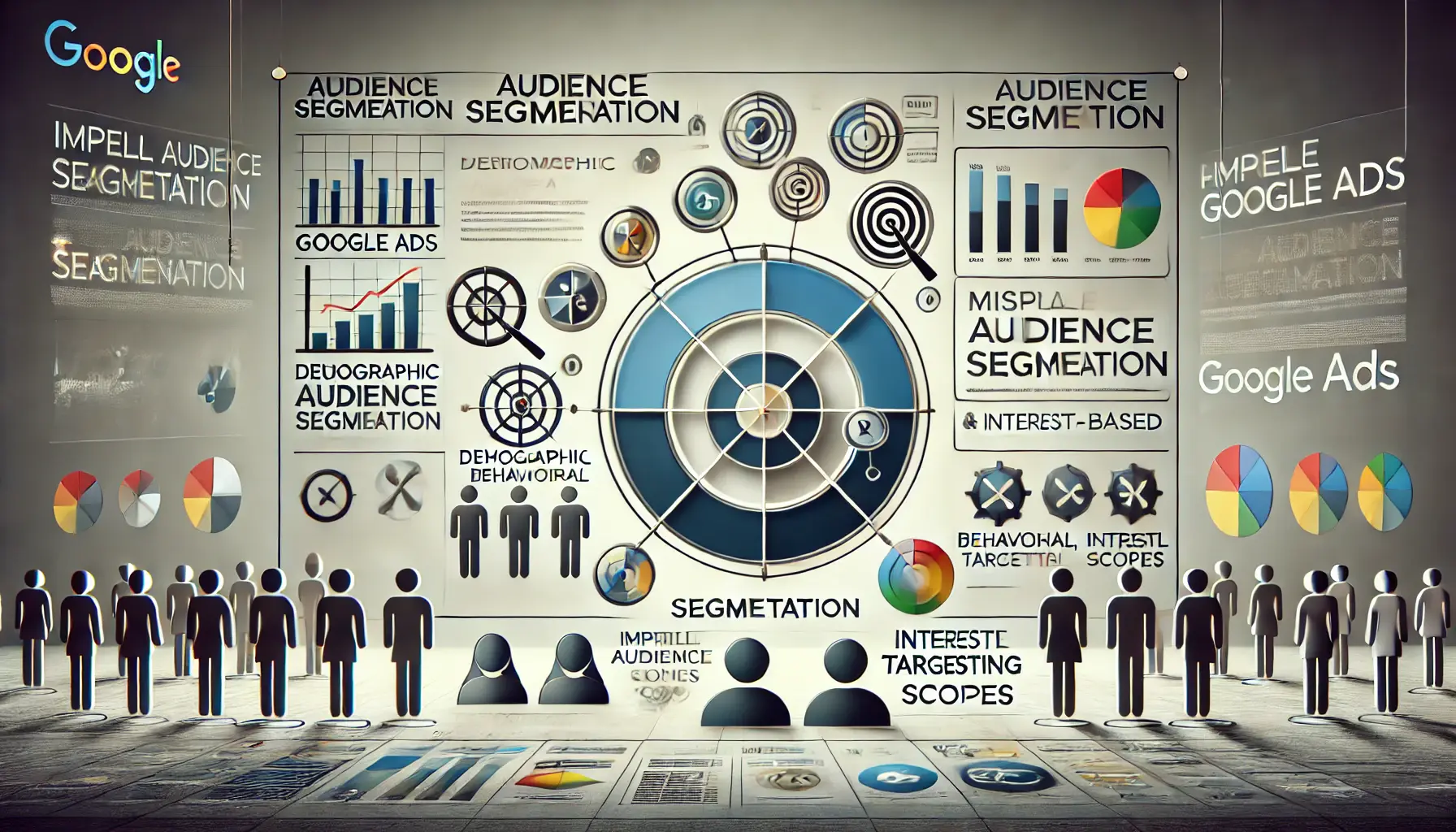
Visualization of improper audience segmentation in Google Ads and its impact on targeting precision.
Improper Audience Segmentation
Targeting broad audiences without proper segmentation can dilute your message and reduce relevance.
Grouping keywords and ads based on consumer intent and relevance enhances targeting precision, leading to higher engagement and better ROI.
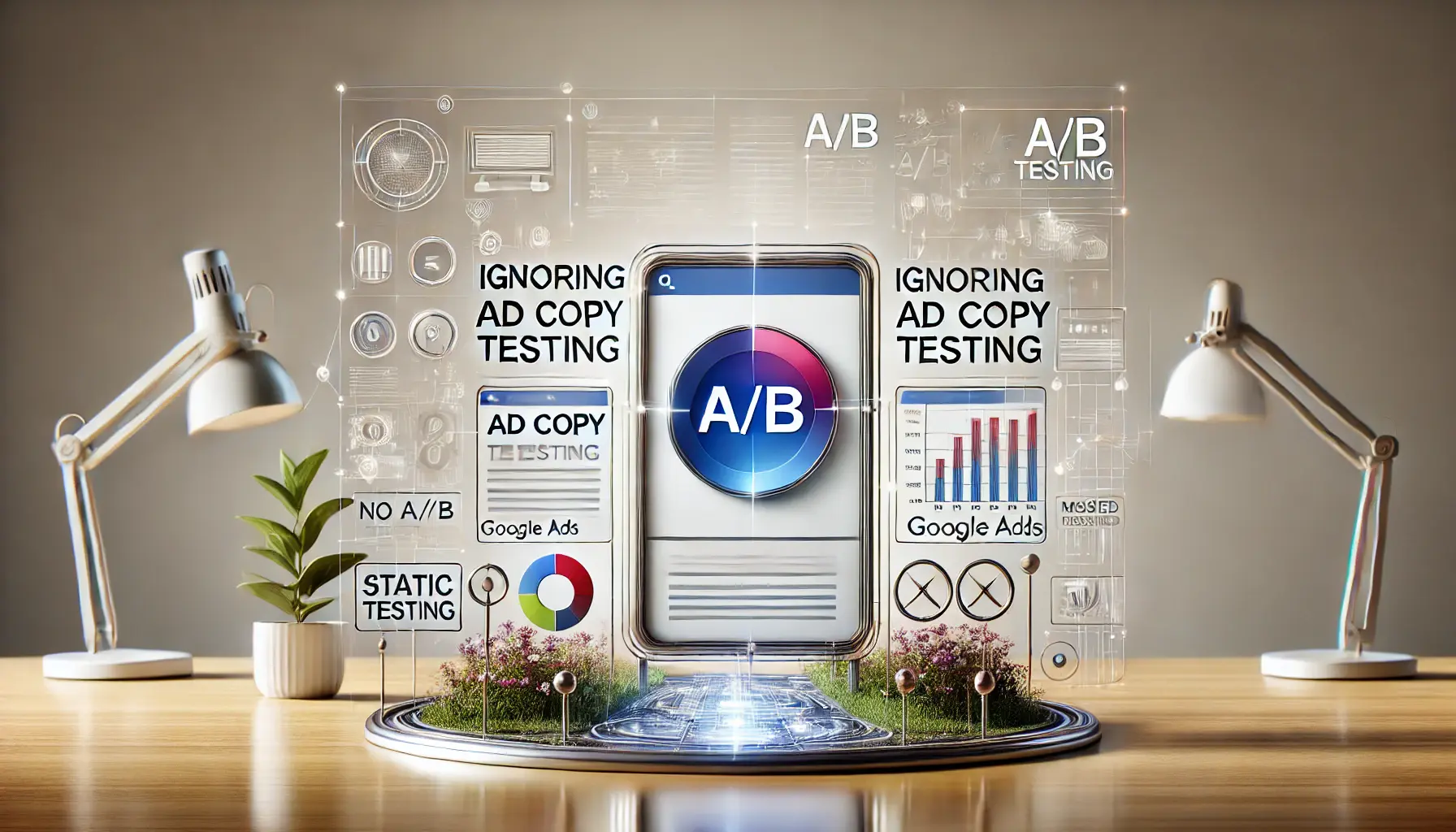
Visualization of ignoring ad copy testing in Google Ads and the missed opportunities for optimization.
Ignoring Ad Copy Testing
Not testing different ad variations can prevent you from identifying the most effective messaging.
Regular A/B testing of headlines, descriptions, and calls-to-action helps refine your ads to better align with consumer intent and improve performance.

Visualization of relying solely on broad match keywords and its inefficiency in Google Ads targeting.
Relying Solely on Broad Match Keywords
Using broad match keywords alone can cause your ads to show for unrelated searches, leading to inefficient spending.
Incorporating phrase and exact match keywords, together with negative keywords, ensures your ads target the most relevant queries.
By avoiding these common mistakes, you can better align your Google Ads campaigns with consumer intent, driving more effective advertising and improved business outcomes.
Avoid neglecting negative keywords, conversion tracking, and ad testing to prevent campaign inefficiencies.

Visualization of mastering consumer intent to optimize Google Ads campaigns for success.
Mastering Consumer Intent for Successful Google Ads Campaigns
Effectively understanding and leveraging consumer intent is the foundation of a high-performing Google Ads campaign.
Throughout this article, we have explored various strategies to harness consumer intent, optimize campaigns, and achieve measurable success.
In this final section, we encapsulate the key takeaways to ensure you have actionable insights to apply immediately.

Visualization of key strategies to capture consumer intent effectively in Google Ads campaigns.
Key Strategies for Capturing Consumer Intent
Successfully targeting consumer intent involves a combination of understanding user behavior and using the tools at your disposal effectively.
Highlights include:
- Understand Intent Types: Tailor your ads to informational, navigational, and transactional intents to meet users where they are in their journey.
- Use Precise Keywords: Research and implement keywords that accurately reflect consumer intent while filtering out irrelevant searches using negative keywords.
- Optimize Campaigns: Regularly test ad copy, utilize audience segmentation, and leverage tools like Smart Bidding to enhance targeting precision.
- Track and Measure Results: Implement robust conversion tracking to gather actionable data and refine your strategies for ongoing success.

Visualization of common pitfalls to avoid in digital advertising campaigns.
Common Pitfalls to Avoid
In your pursuit of targeting consumer intent, it’s essential to avoid these common mistakes:
- Overlooking negative keywords, leading to wasted ad spend.
- Neglecting conversion tracking, which makes performance analysis impossible.
- Targeting broad audiences without proper segmentation, reducing ad relevance.
- Failing to test ad variations, which hinders optimization efforts.
- Relying solely on broad match keywords, resulting in inefficient targeting.
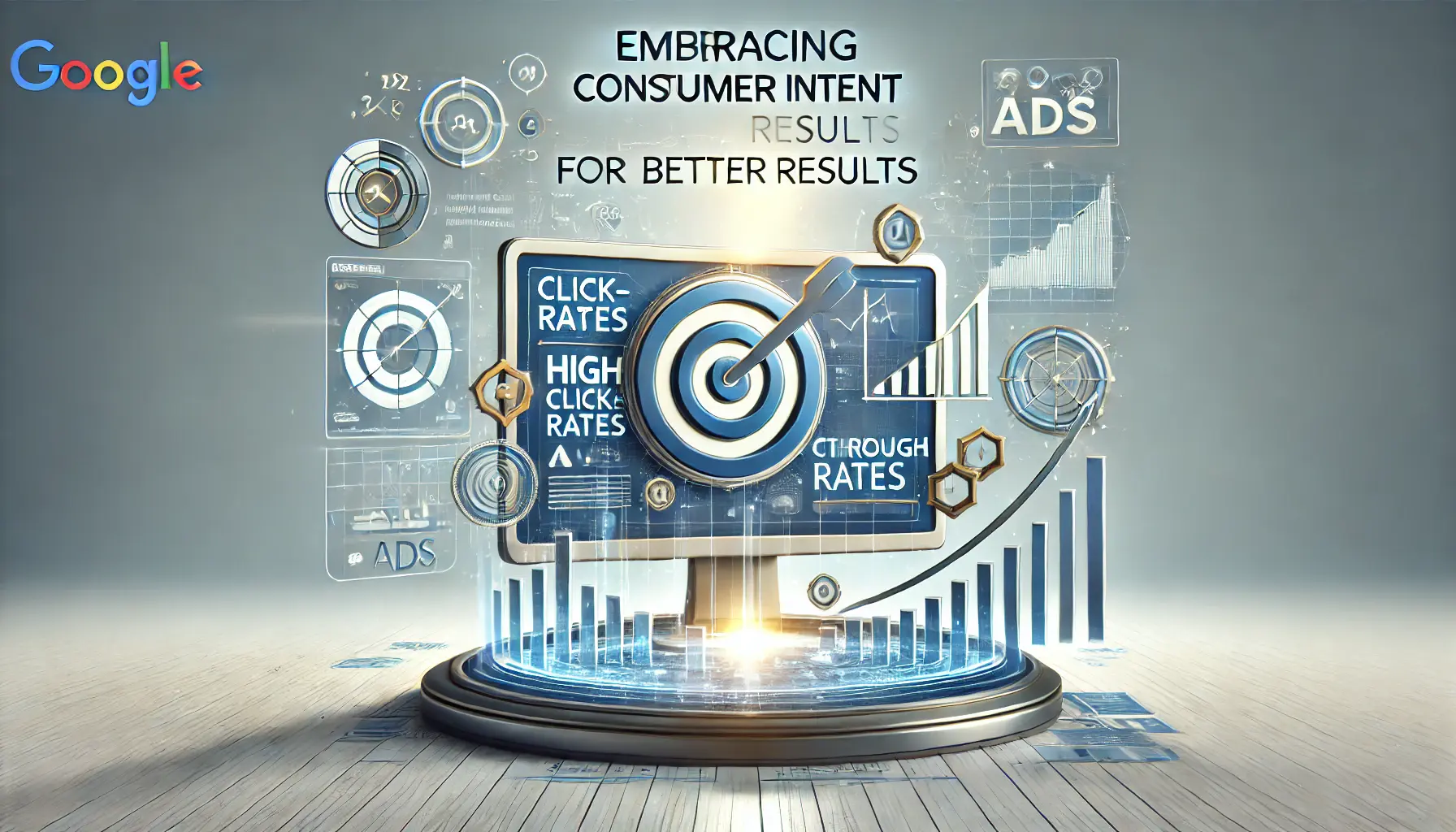
Visualization of embracing consumer intent for improved results in Google Ads campaigns.
Embrace Consumer Intent for Better Results
By focusing on consumer intent in your Google Ads campaigns, you will create a far better alignment between users’ needs and your offerings.
This serves not only to heighten engagement but also to drive higher conversion rates and a better ROI.
Focus on the following activities:
- Refine your keyword strategy for targeting high-intent users.
- Leverage Google Ads features for precision targeting, such as audience segments and Smart Bidding.
- Analyze campaign data to identify trends and make informed adjustments.
When done properly, targeting consumer intent transforms your Google Ads campaigns into powerful business multipliers.
Success comes from understanding your audience well and creating value with relevant and properly structured advertising.
Success lies in understanding consumer intent types, using precise keywords, and continuously optimizing campaigns.

Illustration of frequently asked questions related to consumer intent in Google Ads, emphasizing inquiry and data-driven insights.
Your campaigns can be managed by an agency specialized in Google Ads, check out our service page.
Frequently Asked Questions About Consumer Intent in Google Ads
Understanding consumer intent is crucial for optimizing your Google Ads campaigns.
Below are some common questions and concise answers to help you navigate this important aspect of digital marketing.
Consumer intent refers to the underlying purpose behind a user’s search query, indicating whether they’re seeking information, comparing options, or ready to make a purchase.
Aligning your ads with consumer intent ensures your messages resonate with users’ needs, leading to higher engagement and improved conversion rates.
The main types are informational, where users are trying to attain knowledge; navigational, where a specific website is being sought; and transactional, where users are ready to buy something.
Keywords can indicate intent: informational intent uses words like ‘how’ or ‘best,’ while transactional intent may include terms like ‘buy’ or ‘discount.’
Segmenting your audience allows you to tailor ads to specific user groups, ensuring relevance and increasing the likelihood of conversions.
Negative keywords prevent your ads from showing on irrelevant searches, ensuring your budget is spent reaching users with genuine interest.
Well-crafted ad copy that speaks directly to the user’s intent can significantly increase click-through rates and conversions.
Utilize tools like Smart Bidding, audience segments, and search term insights to align your campaigns with user intent effectively.
Common pitfalls include overlooking negative keywords, neglecting conversion tracking, and failing to test ad variations.













